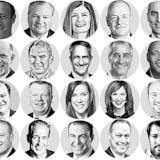Two major manufacturing indexes dipped into negative territory for the first time since May 2020.
Ernie Goss, who leads Creighton University's Mid-America Business Conditions Index, said the monthly survey of supply managers is flashing warning signs of a possible recession in the first half of 2023.
"I think it's going to be a shallow recession," Goss said. "It's not just this month's reading. It's what we've been seeing over the last several months of moving lower and lower."
Since hitting 71.3 in March, the business conditions index for nine central states, which includes Minnesota, has fallen six of of the last eight months. The leading indicator fell into contractionary territory, which is anything below 50 on the 0 to 100 scale, with a reading of 48 in November, down from 53.1 in October.
"It's the lowest reading we've recorded since the early days of the pandemic," said Goss, adding that the sector had held up well until now but is now showing signs of weakness.
Minnesota's index fell to 48.8 in November, down from 53.5 in October. New orders, production or sales, and employment were all in negative territory, while delivery lead times and inventories were slightly positive.
A national barometer of the manufacturing sector put out by the Institute for Supply Management, which uses the same methodology, also came in below growth neutral last month. It was at 49, down from 50.2 in October.
In the mid-America survey, supply managers said higher input prices was their biggest challenge for the rest of the year and heading into 2023.


